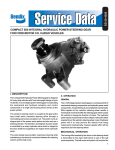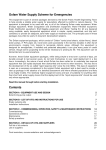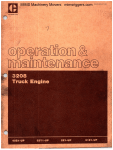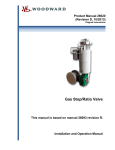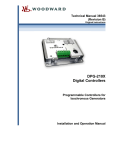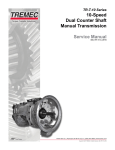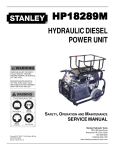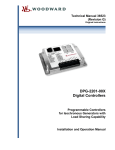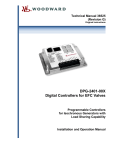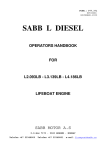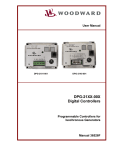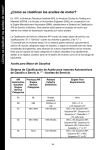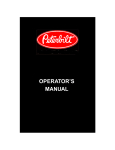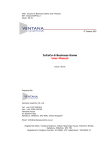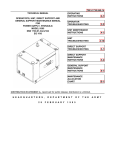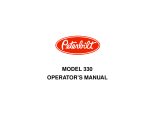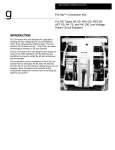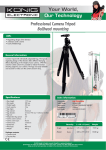Download TG-10 Governor
Transcript
Installation and Operation Manual TG-10 Governor Manual 04041 (Revision J) • DEFINITIONS • • • • This is the safety alert symbol. It is used to alert you to potential personal injury hazards. Obey all safety messages that follow this symbol to avoid possible injury or death. DANGER—Indicates a hazardous situation which, if not avoided, will result in death or serious injury. WARNING—Indicates a hazardous situation which, if not avoided, could result in death or serious injury. CAUTION—Indicates a hazardous situation which, if not avoided, could result in minor or moderate injury. NOTICE—Indicates a hazard that could result in property damage only (including damage to the control). IMPORTANT—Designates an operating tip or maintenance suggestion. The engine, turbine, or other type of prime mover should be equipped with an overspeed shutdown device to protect against runaway or damage to the prime mover with possible personal injury, loss of life, or property damage. The overspeed shutdown device must be totally independent of the prime mover control system. An overtemperature or overpressure shutdown device may also be needed for safety, as appropriate. Read this entire manual and all other publications pertaining to the work to be performed before installing, operating, or servicing this equipment. Practice all plant and safety instructions and precautions. Failure to follow instructions can cause personal injury and/or property damage. This publication may have been revised or updated since this copy was produced. To verify that you have the latest revision, be sure to check the Woodward website: www.woodward.com/pubs/current.pdf The revision level is shown at the bottom of the front cover after the publication number. The latest version of most publications is available at: www.woodward.com/publications If your publication is not there, please contact your customer service representative to get the latest copy. Any unauthorized modifications to or use of this equipment outside its specified mechanical, electrical, or other operating limits may cause personal injury and/or property damage, including damage to the equipment. Any such unauthorized modifications: (i) constitute "misuse" and/or "negligence" within the meaning of the product warranty thereby excluding warranty coverage for any resulting damage, and (ii) invalidate product certifications or listings. To prevent damage to a control system that uses an alternator or battery-charging device, make sure the charging device is turned off before disconnecting the battery from the system. To prevent damage to electronic components caused by improper handling, read and observe the precautions in Woodward manual 82715, Guide for Handling and Protection of Electronic Controls, Printed Circuit Boards, and Modules. Revisions—Text changes are indicated by a black line alongside the text. Woodward Governor Company reserves the right to update any portion of this publication at any time. Information provided by Woodward Governor Company is believed to be correct and reliable. However, no responsibility is assumed by Woodward Governor Company unless otherwise expressly undertaken. © Woodward 1978 All Rights Reserved Manual 04041 TG-10 Governor Contents CHAPTER 1. GENERAL INFORMATION ........................................................... 1 Introduction .............................................................................................................1 Description ..............................................................................................................1 References .............................................................................................................3 CHAPTER 2. INSTALLATION.......................................................................... 4 Introduction .............................................................................................................4 Receiving ................................................................................................................4 Storage ...................................................................................................................4 Drive Shaft Rotation ...............................................................................................5 Changing Drive Shaft Rotation ...............................................................................5 Governor Mounting ...............................................................................................13 Linkage Attachments ............................................................................................14 Heat Exchanger Installation (optional) .................................................................14 Oil Supply .............................................................................................................15 When is a Heat Exchanger Necessary? ...............................................................18 CHAPTER 3. GOVERNOR OPERATION AND ADJUSTMENTS .......................... 19 Introduction ...........................................................................................................19 Initial Operation ....................................................................................................19 Speed Droop ........................................................................................................20 Droop Adjustment .................................................................................................20 CHAPTER 4. PRINCIPLES OF OPERATION ................................................... 22 Introduction ...........................................................................................................22 Description Of Operation ......................................................................................23 CHAPTER 5. TROUBLESHOOTING ............................................................... 26 Introduction ...........................................................................................................26 Visual Inspection ..................................................................................................26 Definitions .............................................................................................................26 CHAPTER 6. REPLACEMENT PARTS ........................................................... 29 Replacement Parts Information ............................................................................29 CHAPTER 7. SERVICE OPTIONS ................................................................. 38 Product Service Options .......................................................................................38 Woodward Factory Servicing Options ..................................................................39 Returning Equipment for Repair ...........................................................................40 Replacement Parts ...............................................................................................40 Engineering Services............................................................................................41 How to Contact Woodward ...................................................................................41 Technical Assistance ............................................................................................42 Woodward i TG-10 Governor Manual 04041 Illustrations and Tables Figure 1-1. The TG-10 Governor ............................................................................1 Figure 1-2. Governor Work Output .........................................................................2 Figure 2-1. Pump Housing Assembly .....................................................................5 Figure 2-2. Pump Housing Assembly .....................................................................6 Figure 2-3. Location of Pump Drive Pin .................................................................6 Figure 2-4. Pump Housing Assembly .....................................................................7 Figure 2-5. Set-up for cw Rotation of the Governor Drive Shaft ............................7 Figure 2-6. Set-up for ccw Rotation of the Governor Drive Shaft ...........................8 Figure 2-7. TG-10 Outline Drawing–Screw Speed Setting; Cast-Iron Case ..........9 Figure 2-8. TG-10 Outline Drawing–Lever Speed Setting; Cast-Iron Case .........10 Figure 2-9. TG-10 Outline Drawing–Screw Speed Setting; Die-Cast Aluminum Case.................................................................................................11 Figure 2-10. TG-10 Outline Drawing–Lever Speed Setting; Die-Cast Aluminum Case.................................................................................................12 Figure 2-11. Heat Exchanger Tap Locations........................................................14 Figure 2-12. Heat Exchanger Piping Schematic ..................................................15 Figure 3-1. Droop Adjusting Lever Movement......................................................21 Figure 4-1. TG-10 Schematic Diagram ................................................................22 Figure 4-2. TG-10 Schematic Diagram ................................................................25 Figure 6-1. TG-10 Parts–Cast-Iron Case; Screw Speed Setting .........................31 Figure 6-2. TG-10 Parts–Cover Assembly (Lever Speed Setting) for Use with Cast-Iron Case TG-10 .....................................................................33 Figure 6-3. TG-10 Parts–Die-Cast Aluminum Case; Screw Speed Setting .........35 Figure 6-4. TG-10 Parts–Cover Assembly (Lever Speed Setting) for Use with Aluminum Case TG-10 ....................................................................37 Table 2-1. Oil Chart ..............................................................................................16 Table 2-2. Viscosity Comparisons ........................................................................16 Table 5-1. TG-10 Troubleshooting .......................................................................27 ii Woodward Manual 04041 TG-10 Governor Chapter 1. General Information Introduction This manual provides general information, installation, operation and adjustments, principles of operation, troubleshooting, and replaceable parts for the Woodward TG-10 governor. Description The Woodward TG-10 is a mechanical-hydraulic speed droop governor for controlling steam turbines—applications where isochronous (or constant-speed) operation is not required. The TG-10 governor has 32 degrees of maximum shaft travel. Recommended travel from the no-load to the full-load position is 2/3 of full governor travel. The TG-10 provides a maximum work capacity of 10 ft-lb (14 J) through a serrated terminal shaft extending from both sides of the case. Stalled torque is 175 lb-in (19.8 Nxm), and rated work capacity is 60 to 70 percent of maximum work, not to exceed 7 ft-lb (9.5 J). See Figure 1-2 for a graphic representation of maximum work capacity for the TG-10 and related terminal shaft travel information. The governor is set to the speed range specified by customer at time of order. The high-speed governor (4000 to 6000 rpm) may require a heat exchanger in some applications (see When is a Heat Exchanger Necessary? in Chapter 2). The TG-10 is capable of controlling at lower-than-specified speed range with some loss of output torque and performance. Figure 1-1. The TG-10 Governor Woodward 1 TG-10 Governor Manual 04041 Figure 1-2. Governor Work Output The TG-10 governor is available in two different types of construction, a cast-iron case or a die-cast aluminum case. Speed droop is required for stable governor operation and is factory set, but is internally adjustable. Two means of speed setting are available for the TG-10. Screw speed setting with a cover-top adjusting screw is standard. Lever speed-setting is optional and provided by a serrated shaft assembly extending from both sides of the cover. The TG-10 governor is identified by the type of its cover assembly, and is commonly referred to as a TG-10 or a TG-10 Lever. Governor drive-shaft rotation is single direction only, but rotation is changeable in the field by an internal adjustment on the cast-iron TG-10, and by an external adjustment on the die-cast aluminum TG-10 (see Chapter 2). Clockwise (cw) or counterclockwise (ccw) rotation is determined when viewing from the governor top. On some models, direction of rotation is marked by a decal on the governor side, on other models it is stamped cw or ccw on the governor nameplate. The internal pump is sized to operate over standard speed ranges: 1100 to 2400 rpm 2400 to 4000 rpm 4000 to 6000 rpm Maintenance of the TG-10 is minimal due to few moving parts, weatherproof design, and self-contained oil supply. The governor drive shaft operates a gerotor-type oil pump. Internal oil pump pressure is regulated by a relief valve/accumulator. On some models, a single oil sight gauge can be installed on either side of the governor case. On other models, an oil sight gauge is installed on each side of the governor case. Either type of installation makes oil condition and oil-level checking simple. 2 Woodward Manual 04041 TG-10 Governor References The following publications may prove useful. Number 25071 25075 36641 50014 50015 Woodward Title Oils for Hydraulic Controls Commercial Preservation Packaging for Storage of MechanicalHydraulic Controls Governor Oil Heat Exchanger Service Bulletin, describes the drilling of an oil relief hole in the TG-10 pump housing not previously modified to reduce seal wear Service Bulletin, describes the drilling and tapping of a hole in TG-10 cases not previously modified for the addition of an oil cooler 3 TG-10 Governor Manual 04041 Chapter 2. Installation Introduction Use care while handling and installing the TG-10. Be particularly careful to avoid striking the drive shaft, terminal shafts, and speed setting shafts or adjusting screw. Abuse can damage seals, internal parts, and factory adjustments. Do not rest the governor on its drive shaft. The engine, turbine, or other type of prime mover should be equipped with an overspeed shutdown device to protect against runaway or damage to the prime mover with possible personal injury, loss of life, or property damage. The overspeed shutdown device must be totally independent of the prime mover control system. An overtemperature or overpressure shutdown device may also be needed for safety, as appropriate. Receiving The TG-10 is shipped from the factory bolted to a wooden platform in the vertical position and boxed. The oil sight gauge is factory installed on the left side of the case, and a breather/filler cap is positioned for vertical governor mounting and operation. On late TG-10 models, an oil sight gauge is installed on each side of the case. After factory testing and adjusting, the TG-10 is drained of oil, sealed, and painted. This leaves a light film of oil covering internal parts to prevent rust. External shafts are coated with a spray lubricant. No internal cleaning or flushing is necessary before installation and operation or customer retesting. Storage The TG-10 may be stored for short periods of time as received from the factory. For long term storage in a hostile environment (large temperature changes, humid or corrosive atmosphere), or if the governor is installed on the turbine for storage, fill the governor with oil and follow preservation packaging instructions in Woodward manual 25075, Commercial Preservation Packaging for Storage of Mechanical-Hydraulic Controls. If the breather/filler cap has been moved for horizontal governor operation and the governor is to be stored vertically, replace the cap with a plug before filling the governor with oil to prevent oil from draining through the cap. 4 Woodward Manual 04041 TG-10 Governor Drive Shaft Rotation Governor drive shaft rotation for Woodward governors is determined when looking at the governor from the top. The correct direction of rotation of the TG-10, when viewed from the top of the governor, is stamped “cw” or “ccw” on the governor nameplate. Governor drive shaft rotation is single direction only. When looking at the governor from the top, the direction of rotation must be the same as the turbine shaft rotation when looking at the mounting pad. If the governor oil pump is rotated in the wrong direction, oil pressure is no longer generated. Pump parts start heating up, which can result in possible seizure of rotating parts. Be sure governor drive and turbine drive rotation is the same when looking at the governor and the mounting pad from the top. Incorrect drive rotation may cause governor damage. Changing Drive Shaft Rotation TG-10 with a Pump Eccentric not Machined into the Base See Figure 2-1. Use the following procedure: 1. See Figures 2-1, 2-2, and 2-3. 2. Remove the governor from the turbine. Drain the oil from the governor. 3. Place the governor on its side with the cooler tap up. 4. Turn the key slot on the drive shaft to face up. 5. Remove the four pump housing screws and remove the pump housing. 6. Notice the directional arrows stamped on the pump housing. Turn the eccentric ring so the pin hole is next to the arrow for desired shaft rotation. Figure 2-1. Pump Housing Assembly 7. Woodward Insert the pin into the pin hole in the eccentric (pin must drop below flush). 5 TG-10 Governor 8. Manual 04041 Place the inner and outer gear in the pump housing. Figure 2-2. Pump Housing Assembly 9. Be sure the key slot in the drive shaft is turned up and the square headed pump drive pin is in place. 10. Install the pump housing assembly on the drive shaft and align the slot in the inner gear with the pump drive pin. Do not turn the drive shaft in order to engage the outer and inner pump gears. It is possible for the pump drive pin to fall out if the drive shaft is turned. The square head on the pump drive pin must remain against the case bottom as shown in Figure 2-3. Figure 2-3. Location of Pump Drive Pin 11. Fasten the pump housing to the case with four screws and torque to 300 lb-in (34 Nxm). 12. Check that the drive shaft rotates freely. 13. Place the ballhead retaining collar on the drive shaft. Leave 0.010 inch (0.25 mm) clearance between the pump housing and collar. Torque to 50 lb-in (5.6 Nxm). If the drive shaft does not rotate freely, loosen the four pump housing screws, align the pump, and tighten the screws. 6 Woodward Manual 04041 TG-10 Governor TG-10 with a Pump Eccentric Machined into the Base See Figure 2-4. Use the following procedure: 1. See Figures 2-4 and 2-5. 2. Remove the four pump housing screws. Hold the pump housing assembly flat against the governor case when rotating pump housing 180 degrees (see WARNING below). Figure 2-4. Pump Housing Assembly 3. Rotate the pump housing assembly 180°. 4. Align the arrow on the pump housing with the reference point on the governor case. Figure 2-5 shows the set-up for cw rotation of the governor drive shaft. Figure 2-5. Set-up for cw Rotation of the Governor Drive Shaft Woodward 7 TG-10 Governor Manual 04041 Figure 2-6 shows the set-up for ccw rotation of the governor drive shaft. Figure 2-6. Set-up for ccw Rotation of the Governor Drive Shaft As seen above in Figure 2-5, a TG-10 described as having a “clockwise rotation” is set using the arrow that points counterclockwise next to the reference point on the governor case. And a TG-10 described as having a “counterclockwise rotation”, as in Figure 2-6, is set using the arrow that points clockwise next to the reference point on the governor case. This is because normal rotation is stated viewing the governor from the top and that the governor is viewed from the bottom while changing rotation. 5. If the governor is fitted with a speed setting screw, turn the speed setting screw fully cw. If the governor is fitted with a lever speed setting, bring the speed setting shaft to the maximum fuel position using serration wrench 030943, and hold the speed setting shaft in that position. This will compress the governor speeder spring and prevent a possible separation of the governor drive shaft (124) from the ballhead assembly (123). See Figure 6-3. Now keep maintaining pressure on the speeder spring while replacing the four screws, and torque to 80 lb-in (9.0 Nxm). 6. Check that the drive shaft rotates freely. 7. Remove the cover and check that the ballhead is rotating when the pump drive shaft is rotated. It is possible to reassemble the pump with the ballhead disengaged. If this should be allowed to happen, the governor would call for maximum fuel causing a possible dangerous overspeed. Death, personal injury and/or extensive damage can result to equipment if the governor pump is reassembled with the ballhead shaft and the pump drive shaft disconnected. Maintenance of the TG-l0 is minimal due to few moving parts, weatherproof design, and self contained oil supply. The governor drive shaft operates a gerotor type oil pump. Internal oil pump pressure is regulated by a relief valve/accumulator. The oil sight gauge makes oil conditions and oil level checking simple. 8 Woodward Manual 04041 TG-10 Governor Figure 2-7. TG-10 Outline Drawing–Screw Speed Setting; Cast-Iron Case (Do not use for construction.) Woodward 9 TG-10 Governor Manual 04041 Figure 2-8. TG-10 Outline Drawing–Lever Speed Setting; Cast-Iron Case (Do not use for construction.) 10 Woodward Manual 04041 TG-10 Governor Figure 2-9. TG-10 Outline Drawing–Screw Speed Setting; Die-Cast Aluminum Case (Do not use for construction.) Woodward 11 TG-10 Governor Manual 04041 Figure 2-10. TG-10 Outline Drawing–Lever Speed Setting; Die-Cast Aluminum Case (Do not use for construction.) 12 Woodward Manual 04041 TG-10 Governor Governor Mounting This governor can be mounted either vertically or horizontally. Mounting is called vertical or horizontal if the drive shaft is in a vertical or horizontal position when viewing the governor installed on its mounting base. The breather/filler cap and the drain plug are factory installed for vertical governor operation. For horizontal operation, the cap and drain plug must be moved to their alternate positions. This places the servo piston on the bottom, keeping it completely immersed in oil and preventing air from being trapped in the servo. See outline drawings, Figures 2-7, 2-8, 2-9, and 2-10, for alternate cap and plug positions as well as governor mounting hole locations and hole sizes. The oil sight gauge may be moved to the right side, if desirable. For horizontal operation, the TG governor must be installed with the oil sight gauge at the top of the governor, as shown in the outline drawings. Make sure there is adequate clearance for attaching the fuel control or steam valve linkage, manual speed adjustment or speed setting lever linkage, and for oil maintenance. The governor requires 1/2 hp (373 W) maximum to turn the drive shaft at rated speed. A decal on the side of the case indicates the direction of rotation when shipped from the factory. On later TG-10 models, the correct direction of rotation is stamped “cw” or “ccw” on the governor nameplate. (Governor drive shaft rotation for Woodward governors is determined when looking at the governor from the top). Be sure turbine drive and governor drive directions of rotation are the same. Incorrect drive rotation may cause governor damage. Make sure the drive shaft turns freely before installing the TG-10. Mount the governor squarely on the mounting pad, installing the correct length coupling with a number 5 Woodruff key. Use a gasket between the governor and the engine mounting pad. There must be no binding, side loading, or backlash in the governor drive. Improper alignment or too tight a fit between parts can result in excessive wear or seizure and may also cause undesirable “jiggle”, noticeable at governor output during operation. There must be no force pushing the drive shaft into the governor. Tighten the four governor mounting bolts equally. Woodward 13 TG-10 Governor Manual 04041 Linkage Attachments Terminal Shaft The terminal shaft extends from both sides of the case and provides 30° travel. 20° travel is recommended between no load and full load. Installed linkages must operate smoothly, free of binding, and can be spring loaded in the shutdown direction only to remove looseness. Be sure to allow sufficient overtravel at each end of the terminal shaft so the governor can create a shutdown and also give maximum steam flow when required. Failure to provide sufficient overtravel at minimum fuel position can prevent the governor from shutting down the prime mover and result in possible damage to equipment and personal injury. Speed Setting Linkage If the TG-10 is equipped with optional lever speed setting, linkage to the speed setting shaft on either side must be installed. Lever speed setting requires 30° travel for full governor speed range. An internal return spring force on the speed setting shaft is 22 lb-in (2.5 Nxm) maximum. Speed setting linkage must also operate smoothly, without binding or looseness. Heat Exchanger Installation (optional) If it is necessary to install a heat exchanger, mount it below governor oil level in order to prevent overflow of oil through the governor breather/filler cap. Flush the heat exchanger before installation. Make the required piping connections to the cooler and the governor. See Figures 2-7, 2-8, 2-9, and 2-10, which illustrate tap locations and piping connections. Notice in Figure 2-11, Heat Exchanger Tap Locations, that there are two tap locations for the oil from cooler outlet. Which tap location is used depends on the governor mounting position. Figure 2-11. Heat Exchanger Tap Locations 14 Woodward Manual 04041 TG-10 Governor Figure 2-12. Heat Exchanger Piping Schematic TG-10 governors assembled after October 1976 have been factory drilled and tapped with the oil to cooler inlet so the cooler can be easily added. TG-10 governors assembled without this factory tapped hole must be drilled and tapped, per Woodward TG-10 Service Manual 50015, before a cooler can be added. See Figure 2-11 for the approximate location of this tapped hole. Pipe must be sized to minimize pipe pressure losses which must not exceed 15 psi (103 kPa). Oil flow from the oil to cooler inlet tap (0.125”-27 NPTF) on a governor operating at 6000 rpm and using a 0.188 thick gerotor pump (0.188 is standard thickness on high-speed governors) is 1 US gal/min (3.8 L/min) at 150 psi (1034 kPa). Install a governor oil drain in the oil from cooler outlet pipe at the lowest point in the system. See Figure 2-12. It is recommended that a throttling device be installed so that coolant flow to the heat exchanger can be regulated for optimum oil operating temperature. Excessive cooling of governor oil can cause marginal operation. Oil Supply Remove the breather/filler cap and fill the governor with 1.75 qt (1.7 L) of oil to a level visible on the oil sight gauge. Additional oil is required if the governor uses an oil heat exchanger. Always check that the oil level is visible on the oil sight gauge before starting. After the engine is started and the governor is at operating temperature, add oil if necessary. Use an oil depending on operating temperature for the governor (see Table 2-1). Primary concern is for the oil properties in the governor. Use the information given in Tables 2-1 and 2-2 as a guide in the selection of a suitable lubricating! hydraulic oil. Oil grade selection is based on the operating temperature range of the governor. Also, use this information to aid in recognizing and correcting common problems associated with oil used in products manufactured by Woodward. Woodward 15 TG-10 Governor Manual 04041 Table 2-1. Oil Chart Table 2-2. Viscosity Comparisons 16 Woodward Manual 04041 TG-10 Governor For applications where the governor shares the oil supply with the engine, use the oil recommended by the engine manufacturer. Governor oil is both a lubricating oil and a hydraulic oil. It must have a viscosity index that allows it to perform over the operating temperature range, and it must have the proper blending of additives that cause it to remain stable and predictable over this range. Governor oil must be compatible with seal materials (nitrile, polyacrylic, and fluorocarbon). Many automotive and gas engine oils, industrial lubricating oils, and other oils of mineral or synthetic origin meet these requirements. Woodward governors are designed to give stable operation with most oils with the viscosity, at the operating temperature, between 50 and 3000 SUS (Saybolt Universal Seconds). At the normal operating temperature, the viscosity should be between 100 to 300 SUS. Poor actuator response or instability may be an indication that the oil viscosity is outside this range. Excessive component wear or seizure in a governor indicates the possibility of: 1. Insufficient lubrication caused by: a. An oil that flows slowly when it is cold, especially during start-up. b. An oil line with restrictions caused by either obstructions within or bends in the line (for external supply governors only). c. No oil in the governor. 2. Contaminated oil caused by: a. Dirty oil containers. b. A governor exposed to heating up and cooling down cycles, which creates condensation of water in the oil. 3. Oil not suitable for the operating conditions caused by: a. Changes in ambient temperature. b. An improper oil level which creates foamy, aerated oil. Operating a governor continuously beyond the high limit temperature of the oil will result in oil oxidation. This is identified by varnish or sludge deposits on the governor parts. To reduce oil oxidation, lower the actuator operating temperature with a heat exchanger or other means, or change to an oil more oxidationresistant at the operating temperature. A loss of stable governor control and possible engine overspeed may result If the viscosity exceeds the 50 to 3000 SUS range. Specific oil viscosity recommendations are given on the Oil Chart (Table 2-1). Select a readily available good brand of oil, either mineral or synthetic, and continue using that same brand. Do NOT mix different classes of oils. Oil that meets the API (American Petroleum Institute) engine service classification in either the “S” group or the “C” group, starting with “SA” or “CA” through “SF” and “CD” is suitable for governor service. Oils meeting performance requirements of the following specifications are also suitable: US MIL-L-2104A, MIL-L-2104B, MlL-L-2104C, MIL-L-46152, MIL-L-46152A, MIL-L-46152B, MIL-L-45199B. Woodward 17 TG-10 Governor Manual 04041 Replace the governor oil if it is contaminated, also change it if it is suspected of contributing to governor instability. Drain the oil while it is still hot and agitated; flush the governor with a clean solvent having some lubricity (such as fuel oil or kerosene) before refilling with new oil. If drain time is insufficient for the solvent to completely drain or evaporate, flush the governor with the same oil it is being refilled with to avoid dilution and possible contamination of the new oil. To avoid recontamination, the replacement oil should be free of dirt, water, and other foreign material. Use clean containers to store and transfer oil. Observe manufacturer’s instructions or restrictions regarding the use of solvents. If no instructions are available, handle with care. Use the cleaning solvent in a well ventilated area away from fires or sparks. Oil that has been carefully selected to match the operating conditions and is compatible with governor components should give long service between oil changes. For governors operating under ideal conditions (minimum exposure to dust and water and within the temperature limits of the oil), oil changes can be extended. If available, a regularly scheduled oil analysis is helpful in determining the frequency of oil changes. Any persistent or reoccurring oil problems should be referred to a qualified oil specialist for solution. The recommended continuous operating temperature of the oil is 140 to 200 °F (60 to 93 °C). The ambient temperature limits are –20 to +200 °F (–29 to +93 °C). Measure the temperature of the governor on the outside lower part of the case. The actual oil temperature will be slightly warmer, by approximately 10 °F (6 °C). When is a Heat Exchanger Necessary? Some applications of the TG-10 may require an oil heat exchanger be used to prevent oil breakdown and subsequent problems due to excessive oil operating temperatures. TG-10 governors operating at low and medium speed ranges (1100 to 2400 rpm and 2400 to 4000 rpm) do not normally require one to be used. The high-speed governor (4000 to 6000 rpm) may require a heat exchanger in some applications. Factors such as oil viscosity, governor speed, heat radiation from surrounding sources, and mounting pad and ambient temperatures affect oil conditions necessitating an oil cooler. See Woodward manual 25071, Oils for Hydraulic Controls. Generally, whenever operating oil exceeds its recommended viscosity/operating temperature range, or when oil viscosity at operating temperature is below 100 SUS, an oil cooler may be required. Late model TG-10 governors are equipped with a cooler tap. Under laboratory test conditions, a single pass, counter-flow heat exchanger with 1 to 2 ft² (0.09 to 0.19 m²) of effective heat transfer area provides adequate cooling for most high-speed TG-10 governor applications. If there is doubt concerning the need for, or size of, a heat exchanger, contact Woodward. 18 Woodward Manual 04041 TG-10 Governor Chapter 3. Governor Operation and Adjustments Introduction This chapter provides initial operating instructions and adjustment features of the TG-10 governor. The engine, turbine, or other type of prime mover should be equipped with an overspeed shutdown device to protect against runaway or damage to the prime mover with possible personal injury, loss of life, or property damage. The overspeed shutdown device must be totally independent of the prime mover control system. An overtemperature or overpressure shutdown device may also be needed for safety, as appropriate. Initial Operation Before initial operation of the TG-10 equipped turbine, check that all previous installation steps are successfully accomplished. Be prepared to make an emergency shutdown when starting the engine, turbine, or other type of prime mover, to protect against runaway or overspeed with possible personal injury, loss of life, or property damage. Normally, the only requirements for putting a new or overhauled governor into service are to fill the governor with oil and adjust the rated speed setting. All other adjustments are accomplished during factory testing according to the turbine manufacturer specifications and should not require further adjustments. Governor speed setting is factory set to give rated speed at initial start-up. If desired, the speed setting may be decreased before start-up by the manual speed setting screw, or by turning the high-speed stop screw cw on lever speed setting models to give low speed at initial start-up. Open the steam valve slowly. Check the turbine speed and adjust as necessary to bring the turbine to rated speed. Make sure the terminal shaft linkage to the valve is correctly adjusted to allow maximum and minimum steam flow requirement. Check the governor for stable operation by manually disturbing the terminal shaft linkage or speed setting. Governor stability is satisfactory when the governor returns to speed with only a slight over or undershoot. Instability indicates the need for adjustment of droop. Woodward 19 TG-10 Governor Manual 04041 Speed Droop Speed droop or simply droop is the simplest method of creating stability in a governor. It is the decrease in speed taking place when the governor terminal shaft moves from the minimum to the maximum fuel position in response to a load increase, expressed as a percentage of rated speed. If instead of a decrease in speed, an increase takes place, the governor is showing a negative droop. Negative droop will cause instability in a governor. Not enough droop can cause instability in the form of hunting, surging, or difficulty in response to a load change. Too much droop can result in slow governor response in picking up or dropping off a load. Droop can be calculated with the following formula: % Droop = No Load Speed – Full Load Speed Full Load Speed x 100 Droop Adjustment The factory-made 6% droop setting for 20° terminal shaft travel will provide sufficient stability for most applications and will not normally need to be adjusted before governor operation. Adjustment may be necessary if the governor has been disassembled. If the governor terminal shaft does not use the full 20° of available travel from “NO LOAD” to “FULL LOAD,” droop will also be reduced proportionately. Adjustment of droop is indicated during governor operation by instability, or difficulty in responding to a load change. Instability, in the form of hunting or surging, indicates insufficient droop, and the droop adjusting lever should be positioned to increase droop. If the TG-10 shows difficulty in accepting load, or where the governor becomes unstable after a load change, excessive droop is indicated. In cases where the droop setting of the governor must be changed on the engine, use the following droop adjusting procedure: 1. The cover assembly must be removed to gain access to the droop adjusting lever. Use care while removing the cover not to damage the cover gasket. If the governor is horizontally mounted, drain governor oil before removing the cover. The cover also fastens internal parts that can fall out, especially on horizontally mounted governors. 2. Loosen the socket head screw which fastens the droop adjusting lever just enough to slide the lever a very small amount, approximately 1/32” (0.8 mm) at a time, in the direction desired to adjust droop. Moving the droop adjusting lever away or towards the terminal shaft center line increases or decreases droop respectively (see Figure 3-1). 3. 20 Tighten the screw, install the cover, and fill with oil to the correct level. Woodward Manual 04041 TG-10 Governor Do not move the droop adjusting lever in the decrease droop direction past the point of zero droop (the center line of the terminal shaft), as this results in a speed Increase in response to a load increase and a subsequent, unstable operation. Figure 3-1. Droop Adjusting Lever Movement 4. Observe governor operating behavior again and repeat adjustments to the droop adjusting lever until governor operation is satisfactory. If repeated attempts at adjustment fail to provide governor stability, other problems are indicated. See Troubleshooting Table 5-1. Do not operate the TG-10 without the cover assembly securely In place. Woodward 21 TG-10 Governor Manual 04041 Chapter 4. Principles of Operation Introduction This chapter describes the operation of the TG-10 governor. This includes an explanation of the hydraulic system and the way oil is distributed. A description of the ballhead assembly, pilot valve function, and the droop slider concludes this chapter. Internally, the TG-10 governor consists of the following basic items: • oil pump • oil accumulator • speeder spring • ballhead and pilot valve bushing assembly • pilot valve plunger • servo piston • droop adjustment • speed adjustment • terminal lever and shafts A schematic diagram (Figure 4-1) shows the relationship of these various items and provides a visual means of understanding the operation of the TG-10 governor. Figure 4-1. TG-10 Schematic Diagram 22 Woodward Manual 04041 TG-10 Governor Description Of Operation Oil Pressure And Distribution The governor is normally driven by the turbine through a flexible coupling. The inner gerotor of the oil pump is keyed to the governor drive shaft and pilot valve bushing. The pump draws oil from the sump and distributes it through the oil passages within the case. Oil is also discharged to the spring-loaded accumulator. The accumulator maintains the 150 psi (1034 kPa) operating pressure at rated speed. Excess pressure compresses the accumulator springs, and oil is released to sump during steady state operation. A change in speed and centrifugal force moves the flyweights out or in. This moves the pilot valve plunger either upward or downward depending on whether it is an increase or decrease in speed. Plunger movement opens the control port and releases oil either to sump or to the underside of the servo piston. During servo piston movement in the increase fuel direction, the accumulator supplements the system oil supply with its stored volume of high pressure oil and helps maintain the full work capacity of the governor. Ballhead Operation The ballhead assembly contains two flyweights, speeder spring, thrust bearing, pilot valve plunger, and pilot valve bushing. As the flyweights are rotated, they produce a centrifugal force that is opposed by the downward force of the speeder spring. The speeder spring force can be varied by adjusting the speed setting screw, or speed setting lever. A thrust bearing on top of the flyweight toes permits the pilot valve bushing to rotate around the pilot valve plunger. This reduces static friction between the bushing and plunger. Pilot Valve Function When the turbine is running on-speed, the pilot valve plunger is centered, covering the control ports of the pilot valve bushing. In this position, no oil is discharged from, or flows to, the servo piston, and the governor terminal shaft cannot move. A change in either the flyweight centrifugal force or the speeder spring force (speed setting) moves the plunger from its centered position controlling oil flow at the servo piston and moves the servo piston. The pilot valve plunger lowers if: 1. An additional load slows the turbine and governor speed. This decreases the centrifugal force of the rotating flyweights which oppose the force of the speeder spring. 2. The turbine speed is unchanged, but speeder spring force is increased by raising the governor speed setting with the speed setting screw or speed setting lever. Lowering the pilot valve plunger control land opens the control ports. High pressure oil is released to the area below the servo piston forcing the servo piston upwards. This rotates the governor terminal shaft in the increase steam direction. Woodward 23 TG-10 Governor Manual 04041 As the servo piston rises, the speeder spring force is decreased by movement of the terminal lever and allows the pilot valve plunger to rise. The flow of high pressure oil to the servo piston is closed off by the control land, stopping the upward motion of the servo piston. The pilot valve plunger raises if: 1. The centrifugal force of the rotating flyweights is increased by a load decrease on the turbine. This causes an increase in turbine and governor speed. 2. The governor speed is lowered by reducing the speeder spring force with the speed adjusting screw. Raising the pilot valve plunger control land again opens the ports, but this time control oil is released to sump from below the servo piston. High pressure oil in the area above the servo piston cylinder forces the piston down. This rotates the terminal shaft in the decrease steam or fuel direction. Speeder spring pressure increases forcing the pilot valve plunger downward. Terminal shaft movement stops as the control land covers the ports stopping the release of control oil. Droop Adjusting Lever Function Note that as the terminal lever rotates in the increase fuel direction, the droop adjusting lever is lifted and decreases the speeder spring force on the flyweights. Thus, the ballhead is allowed to re-center the pilot valve plunger at lower speeds as fuel is increased. This characteristic is referred to as “speed droop”. Closing the control port stops further movement of the servo piston simultaneously with the return of engine speed to a speed determined by the new speed or spring force. When moving in the decrease fuel direction, the terminal lever lowers the droop adjusting lever and increases the speeder spring force. This increase in speeder spring force re-centers the pilot valve plunger and stops further servo piston movement. The amount of speed change, or droop, for a given amount of terminal shaft rotation depends upon the positioning of the droop adjusting lever on the terminal lever. 24 Woodward Manual 04041 TG-10 Governor Figure 4-2. TG-10 Schematic Diagram Woodward 25 TG-10 Governor Manual 04041 Chapter 5. Troubleshooting Introduction Faults in governor operation are usually revealed as speed variations of the turbine. But, it cannot be assumed that all such variations indicate a fault in the governor. Therefore, when improper operation is evident, check all components, adjustment settings, and the turbine for correct operation. Use the following troubleshooting table to isolate and remedy faults in the governed system. When requesting additional information or service help from Woodward or an authorized service shop, it is important to include in your correspondence the governor part number, serial number, and a complete description of all problems or symptoms. The engine, turbine, or other type of prime mover should be equipped with an overspeed shutdown device to protect against runaway or damage to the prime mover with possible personal injury, loss of life, or property damage. The overspeed shutdown device must be totally independent of the prime mover control system. An overtemperature or overpressure shutdown device may also be needed for safety, as appropriate. Visual Inspection Before attempting to troubleshoot the system, visually check the following items: 1. Check linkages installed between the governor output and a steam valve and any speed setting linkage. Common sources of trouble are binding, lost motion, or inadequate travel. 2. Check the oil for proper level and good condition. Dirty oil causes many governor troubles. Oil contaminated by water, or excessive heat, breaks down rapidly, causing foaming and corroding of internal parts. 3. Check for correct turbine operation. Be sure the drive to the governor drive is smooth, free of torsional vibration. 4. Be sure the speed variations are not the result of load changes beyond the capacity of the turbine. Definitions Terms used in the troubleshooting chart are defined as follows: HUNT A rhythmic variation of speed which can originate in the governor or in the prime mover. See Table 5-1, Paragraph 1 for Troubleshooting Information. A hunt usually has a frequency of less than 50 cycles per minute. 26 Woodward Manual 04041 TG-10 Governor SURGE A rhythmic variation of speed occurring at periodic intervals which can also originate in the governor or in the prime mover. See Table 5-1, Paragraph 1 for Troubleshooting Information. JIGGLE A high frequency vibration of the governor terminal shaft and fuel linkage. See Table 5-1, Paragraph 2, for Troubleshooting information. Do not confuse this with normal controlling action of the governor. A jiggle has a frequency of more than 50 cycles per minute. Be prepared to make an emergency shutdown when starting the engine, turbine, or other type of prime mover, to protect against runaway or overspeed with possible personal injury, loss of life, or property damage. Table 5-1. TG-10 Troubleshooting Symptom 1. The turbine hunts or surges. 2. Governor terminal shaft jiggles. 3. The governor shows difficulty in accepting load, or is unstable as evidenced by a slow and unsteady oscillation, especially after a load change. 4. The turbine does not pick up rated full load. Woodward Cause A. Low oil level. Correction Add oil to a level visible in the oil sight gauge. B. Remove and flush with light weight oil. Dirt in governor. C. Binding terminal shaft linkage. Re-align linkage as necessary. If governor was recently disassembled, check that terminal shaft bearings do not bind internally on the terminal lever. D. Insufficient droop adjustment. A. Improper alignment of the governor drive coupling. Reposition droop adjusting lever to increase droop. B. Worn flyweight pins. A. Insufficient use of terminal shaft travel. Return Governor to factory for repair. Check linkage. Recommended travel is 20° from no load to full load. Check and repair as necessary. NOTE—Droop and its stabilizing effect are a function of governor terminal shaft travel. If the governor terminal shaft linkage is arranged so that only a small percentage of terminal shaft travel is used from no load to full load, droop and its stabilizing effect is reduced proportionately. B. Too much droop. Re-position the droop adjusting lever for decreased droop compensation. C. High steam valve gain. Check that steam valve is not too large or oversize for the particular application. D. A. Dirt in governor oil. Speed setting too low. Drain, flush, and refill with fresh oil. Increase governor speed setting. 27 TG-10 Governor Symptom 5. The turbine does not pick up rated full load. 6. 7. The governor does not start or control. Governor starts, but remains at maximum. 28 Manual 04041 Cause B. Incorrect terminal shaft linkage travel. Correction Check linkage. Recommended travel is 20 0 from no load to full load. C. Governor speed range is incorrect for the particular application. Check speed range of the governor. D. Droop setting too high. A. Wrong governor drive rotation. Re-position the droop adjusting lever to decrease droop. Check turbine drive to the governor. Reverse pump parts for different rotation if necessary. B. Woodruff key not properly installed or missing, drive shaft is not engaged. Check drive installation. C. A. Return governor to factory for repair. Reduce speed setting until governor controls, then adjust for desired speed. Pump drive pin is broken. Speed setting too high. Woodward Manual 04041 TG-10 Governor Chapter 6. Replacement Parts Replacement Parts Information When ordering replacement parts, include the following information: 1. Governor serial number and part number shown on nameplate. 2. Manual number (this manual 04041). 3. Parts reference number in parts list and description of part or part name. Locations of Woodward plants and Woodard authorized repair facilities are listed on the Woodward website (www.woodward.com). Refer to Repair Manual 56101 for correct and safe procedures when disassembly and assembly are required. Replacement Parts List For Figure 6-1 Ref No. 04041-1 04041-2 04041-3 04041-4 04041-5 04041-6 04041-7 04041-8 04041-9 04041-9A 04041-9B 04041-10 04041-11 04041-12 04041-13 04041-14 04041-15 04041-16 04041-17 04041-18 04041-19 04041-20 04041-21 04041-22 04041-23 04041-24 04041-25 04041-26 04041-26A 04041-27 04041-28 04041-28A 04041-29 04041-30 Woodward Part Name ............................................................. Quantity Drive screw .........................................................................2 Governor nameplate ...........................................................1 Breather/Filler cap ..............................................................1 Cover (for screw speed setting) ..........................................1 Cover gasket.......................................................................1 Screw, soc hd .250-20 x 1.00” ............................................3 Flatwasher, .265 x .500” .....................................................1 Droop adjusting lever ..........................................................1 Screw, soc hd sems .250 - 20 x 2.00 .................................2 Washer, .250 Internal shakeproof ......................................2 Washer, .265 x .500 x .064 thick ........................................2 Connecting link (chain link) .................................................1 Servo piston bushing ..........................................................1 Servo piston ........................................................................1 Straight pin ..........................................................................1 Preformed packing ring, 2.114 ID x .070 ............................1 Gerotor oil pump .................................................................1 Pump spacers .................................. (use none, 1, or 2, AR) Pump housing .....................................................................1 Taper pin, #5 .......................................................................2 Oil seal ................................................................................1 Ballhead retainer collar .......................................................1 Screw, soc hd sems .312-18 x 1.00” ..................................4 Terminal shaft .....................................................................2 Oil seal ................................................................................2 Roller bearing .....................................................................2 Pipe plug, .062-27 NPTF ....................................................1 Pipe plug, .125-27 NPTF ....................................................2 Pipe plug, .250-18 NPTF ....................................................1 TG-10 case .........................................................................1 Oil baffle ..............................................................................1 Oil baffle (high speed TG-10 only)......................................1 .................................................................... Not To Be Used Ballhead bushing assembly ................................................1 29 TG-10 Governor Manual 04041 Ref No. Part Name ............................................................. Quantity 04041-31 Terminal lever .................................................................... 1 04041-32 Flyweight pin ...................................................................... 2 04041-33 Flyweight ............................................................................ 2 04041-34 Ballhead cover ................................................................... 1 04041-35 Feedback lever .................................................................. 1 04041-36 Spring clip .......................................................................... 1 04041-37 Pivot block.......................................................................... 1 04041-38 Screw, hx hd ...................................................................... 8 04041-39 Preformed packing ring...................................................... 1 04041-40 Flatwasher, .515 x .875 ..................................................... 1 04041-41 Wave washer ..................................................................... 1 04041-42 Speed setting screw .......................................................... 1 04041-43 Pivot pin ............................................................................. 1 04041-44 High speed stop washer, s.s.............................................. 2 04041-45 Speeder spring screw ........................................................ 1 04041-45A Speeder spring................................................................... 1 04041-46 Pilot valve plunger ............................................................. 1 04041-47 Thrust bearing .................................................................... 1 04041-48 Retaining ring ..................................................................... 1 04041-49 Spring seat ......................................................................... 1 04041-50 Accumulator spring, small.................................................. 1 04041-51 Accumulator spring, large .................................................. 1 04041-52 Accumulator piston ............................................................ 1 04041-53 Oil sight gauge ................................................................... 1 04041-54 Pipe plug, .500-14 NPTF ................................................... 2 04041-55 Pump drive pin, square head ............................................. 1 04041-56 Preformed packing ring, 1.176 ID x .0706 ......................... 1 04041-57 Bore plug............................................................................ 1 04041-58 Retaining ring ..................................................................... 1 04041-59 Preformed packing ring, 1.424 ID x .103 ........................... 1 04041-60 Bore plug............................................................................ 1 04041-61 Retaining ring ..................................................................... 1 04041-62 Rotation decal .................................................................... 1 04041-63 to 79.............................................................................. Not used 30 Woodward Manual 04041 TG-10 Governor Figure 6-1. TG-10 Parts–Cast-Iron Case; Screw Speed Setting Woodward 31 TG-10 Governor Manual 04041 Replacement Parts List For Figure 6-2 Ref No. Part Name ............................................................. Quantity Reference numbers 63 through 79 are not used. 04041-80 04041-81 04041-82 04041-83 04041-84 04041-85 04041-86 04041-87 04041-88 04041-89 04041-90 04041-91 04041-92 04041-93 04041-94 32 Cover (for lever speed setting) .......................................... 1 Bushing .............................................................................. 2 Oil seal ............................................................................... 2 Speed setting shaft ............................................................ 1 Screw, soc hd sems .250-20 x 1.00” ................................. 8 Speed setting shaft lever ................................................... 1 Rollpin,s.s. .188x.750” ....................................................... 1 Spring seat ......................................................................... 1 Speed setting return spring................................................ 1 Speed setting screw assembly .......................................... 1 Straight pin, .124 x .750”.................................................... 1 Roller.................................................................................. 1 Stop lever ........................................................................... 1 Hex nut, .250-28 ................................................................ 2 Set screw, oval point .250-28 x 2.00” ................................ 2 Woodward Manual 04041 TG-10 Governor Figure 6-2. TG-10 Parts–Cover Assembly (Lever Speed Setting) for Use with Cast-Iron Case TG-10 Woodward 33 TG-10 Governor Manual 04041 Replacement Parts List For Figure 6-3 Ref No. Part Name ............................................................. Quantity Reference numbers 95 through 100 are not used. 04041-101 Breather - Filler cap ........................................................... 1 04041-102 Screw - .250-20 x .750..................................................... 14 04041-103 Stop washer ....................................................................... 2 04041-104 Pivot ................................................................................... 1 04041-105 Feedback lever .................................................................. 1 04041-106 Spring clip .......................................................................... 1 04041-107 Screw - .250-20 x 1.000..................................................... 7 04041-108 Droop adjusting lever ......................................................... 1 04041-109 Terminal lever .................................................................... 1 04041-110 Servo piston bushing ......................................................... 1 04041-111 Connecting link assembly .................................................. 1 04041-112 Piston ................................................................................. 1 04041-113 Baffle .................................................................................. 1 04041-114 Ballhead cover ................................................................... 1 04041-115 Speed setting nut ............................................................... 1 04041-116 Speeder screw assembly................................................... 1 04041-117 Speeder spring................................................................... 1 04041-118 Pilot valve plunger ............................................................. 1 04041-119 Bearing race....................................................................... 2 04041-120 Needle thrust bearing ........................................................ 1 04041-121 Flyweight ............................................................................ 2 04041-122 Straight pin ......................................................................... 2 04041-123 Ballhead bushing assembly ............................................... 1 04041-124 Pump drive pin ................................................................... 1 04041-125 Drive shaft .......................................................................... 1 04041-126 Pipe plug - .500 socket head ............................................. 2 04041-127 Case................................................................................... 1 04041-128 Pump housing .................................................................... 1 04041-129 Bowed retaining ring (internal) ........................................... 1 04041-130 Bowed retaining ring - .461 diameter ................................. 1 04041-131 Ball bearing ........................................................................ 1 04041-132 Retaining ring - .461 diameter ........................................... 2 04041-133 Oil seal ............................................................................... 1 04041-134 Oilite bushing ..................................................................... 1 04041-135 Preformed packing - 1.989 ID x .070 ................................. 1 04041-136 Gerotor pump ..................................................................... 1 04041-137 Accumulator piston ............................................................ 1 04041-138 Large accumulator spring .................................................. 1 04041-139 Small accumulator spring .................................................. 1 04041-140 Spring seat ......................................................................... 1 04041-141 Retaining ring - 1.526 diameter ......................................... 1 04041-142 Speed setting screw guide................................................. 1 04041-143 Loading spring ................................................................... 1 04041-144 Washer............................................................................... 1 04041-145 Speed setting screw assembly .......................................... 1 04041-146 Preformed packing - .364 ID x .070 ................................... 1 04041-147 Oil sight gauge ................................................................... 1 04041-148 Needle bearing - .625 ID.................................................... 2 04041-149 Oil seal ............................................................................... 2 04041-150 Terminal shaft .................................................................... 2 04041-151 Cover gasket ...................................................................... 1 04041-152 Cover ................................................................................. 1 04041-153 Nameplate.......................................................................... 1 04041-154 Driver screw - .2 x .188 ...................................................... 2 04041-155 through 160 ............................................................... Not Used 34 Woodward Manual 04041 TG-10 Governor Figure 6-3. TG-10 Parts–Die-Cast Aluminum Case; Screw Speed Setting Woodward 35 TG-10 Governor Manual 04041 Replacement Parts List For Figure 6-4 Ref No. Part Name ............................................................. Quantity Reference numbers 156 through 160 are not used. 04041-161 04041-162 04041-163 04041-164 04041-165 04041-166 04041-167 04041-168 04041-169 04041-170 04041-171 04041-172 04041-173 04041-174 04041-175 04041-176 04041-177 04041-178 04041-179 04041-180 36 Breather/Filler cap ............................................................. 1 Screw - .250-20 x 1.00....................................................... 8 Screw - .250-20 x 1.00 soc hd ........................................... 1 Washer - .250 .................................................................... 1 Stop - Max – Min ................................................................ 1 Oil seal ............................................................................... 2 Bushing .............................................................................. 2 Cover ................................................................................. 1 Lever .................................................................................. 1 Roll pin .188 dia. x .750 ..................................................... 1 Straight pin .124 x .750 ...................................................... 1 Speed setting plunger ........................................................ 1 Screw ................................................................................. 1 Speed setting spring .......................................................... 1 Speed setting screw guide post ......................................... 1 Speed setting plunger guide .............................................. 1 Roller bushing .................................................................... 1 Nut - .250-28 ...................................................................... 2 Set screw - .250-28 x 2.00 ................................................. 2 Speed setting shaft ............................................................ 1 Woodward Manual 04041 TG-10 Governor Figure 6-4. TG-10 Parts–Cover Assembly (Lever Speed Setting) for Use with Aluminum Case TG-10 Woodward 37 TG-10 Governor Manual 04041 Chapter 7. Service Options Product Service Options If you are experiencing problems with the installation, or unsatisfactory performance of a Woodward product, the following options are available: • Consult the troubleshooting guide in the manual. • Contact the manufacturer or packager of your system. • Contact the Woodward Full Service Distributor serving your area. • Contact Woodward technical assistance (see “How to Contact Woodward” later in this chapter) and discuss your problem. In many cases, your problem can be resolved over the phone. If not, you can select which course of action to pursue based on the available services listed in this chapter. OEM and Packager Support: Many Woodward controls and control devices are installed into the equipment system and programmed by an Original Equipment Manufacturer (OEM) or Equipment Packager at their factory. In some cases, the programming is password-protected by the OEM or packager, and they are the best source for product service and support. Warranty service for Woodward products shipped with an equipment system should also be handled through the OEM or Packager. Please review your equipment system documentation for details. Woodward Business Partner Support: Woodward works with and supports a global network of independent business partners whose mission is to serve the users of Woodward controls, as described here: • A Full Service Distributor has the primary responsibility for sales, service, system integration solutions, technical desk support, and aftermarket marketing of standard Woodward products within a specific geographic area and market segment. • An Authorized Independent Service Facility (AISF) provides authorized service that includes repairs, repair parts, and warranty service on Woodward's behalf. Service (not new unit sales) is an AISF's primary mission. • A Recognized Engine Retrofitter (RER) is an independent company that does retrofits and upgrades on reciprocating gas engines and dual-fuel conversions, and can provide the full line of Woodward systems and components for the retrofits and overhauls, emission compliance upgrades, long term service contracts, emergency repairs, etc. • A Recognized Turbine Retrofitter (RTR) is an independent company that does both steam and gas turbine control retrofits and upgrades globally, and can provide the full line of Woodward systems and components for the retrofits and overhauls, long term service contracts, emergency repairs, etc. A current list of Woodward Business Partners is available at www.woodward.com/support. 38 Woodward Manual 04041 TG-10 Governor Woodward Factory Servicing Options The following factory options for servicing Woodward products are available through your local Full-Service Distributor or the OEM or Packager of the equipment system, based on the standard Woodward Product and Service Warranty (5-01-1205) that is in effect at the time the product is originally shipped from Woodward or a service is performed: • Replacement/Exchange (24-hour service) • Flat Rate Repair • Flat Rate Remanufacture Replacement/Exchange: Replacement/Exchange is a premium program designed for the user who is in need of immediate service. It allows you to request and receive a like-new replacement unit in minimum time (usually within 24 hours of the request), providing a suitable unit is available at the time of the request, thereby minimizing costly downtime. This is a flat-rate program and includes the full standard Woodward product warranty (Woodward Product and Service Warranty 5-01-1205). This option allows you to call your Full-Service Distributor in the event of an unexpected outage, or in advance of a scheduled outage, to request a replacement control unit. If the unit is available at the time of the call, it can usually be shipped out within 24 hours. You replace your field control unit with the like-new replacement and return the field unit to the Full-Service Distributor. Charges for the Replacement/Exchange service are based on a flat rate plus shipping expenses. You are invoiced the flat rate replacement/exchange charge plus a core charge at the time the replacement unit is shipped. If the core (field unit) is returned within 60 days, a credit for the core charge will be issued. Flat Rate Repair: Flat Rate Repair is available for the majority of standard products in the field. This program offers you repair service for your products with the advantage of knowing in advance what the cost will be. All repair work carries the standard Woodward service warranty (Woodward Product and Service Warranty 5-01-1205) on replaced parts and labor. Flat Rate Remanufacture: Flat Rate Remanufacture is very similar to the Flat Rate Repair option with the exception that the unit will be returned to you in “likenew” condition and carry with it the full standard Woodward product warranty (Woodward Product and Service Warranty 5-01-1205). This option is applicable to mechanical products only. Woodward 39 TG-10 Governor Manual 04041 Returning Equipment for Repair If a control (or any part of an electronic control) is to be returned for repair, please contact your Full-Service Distributor in advance to obtain Return Authorization and shipping instructions. When shipping the item(s), attach a tag with the following information: • return number; • name and location where the control is installed; • name and phone number of contact person; • complete Woodward part number(s) and serial number(s); • description of the problem; • instructions describing the desired type of repair. Packing a Control Use the following materials when returning a complete control: • protective caps on any connectors; • antistatic protective bags on all electronic modules; • packing materials that will not damage the surface of the unit; • at least 100 mm (4 inches) of tightly packed, industry-approved packing material; • a packing carton with double walls; • a strong tape around the outside of the carton for increased strength. To prevent damage to electronic components caused by improper handling, read and observe the precautions in Woodward manual 82715, Guide for Handling and Protection of Electronic Controls, Printed Circuit Boards, and Modules. Replacement Parts When ordering replacement parts for controls, include the following information: • the part number(s) (XXXX-XXXX) that is on the enclosure nameplate; • the unit serial number, which is also on the nameplate. 40 Woodward Manual 04041 TG-10 Governor Engineering Services Woodward offers various Engineering Services for our products. For these services, you can contact us by telephone, by email, or through the Woodward website. • Technical Support • Product Training • Field Service Technical Support is available from your equipment system supplier, your local FullService Distributor, or from many of Woodward’s worldwide locations, depending upon the product and application. This service can assist you with technical questions or problem solving during the normal business hours of the Woodward location you contact. Emergency assistance is also available during non-business hours by phoning Woodward and stating the urgency of your problem. Product Training is available as standard classes at many of our worldwide locations. We also offer customized classes, which can be tailored to your needs and can be held at one of our locations or at your site. This training, conducted by experienced personnel, will assure that you will be able to maintain system reliability and availability. Field Service engineering on-site support is available, depending on the product and location, from many of our worldwide locations or from one of our FullService Distributors. The field engineers are experienced both on Woodward products as well as on much of the non-Woodward equipment with which our products interface. For information on these services, please contact us via telephone, email us, or use our website and reference www.woodward.com/support, and then Customer Support. How to Contact Woodward For assistance, call one of the following Woodward facilities to obtain the address and phone number of the facility nearest your location where you will be able to get information and service. Electrical Power Systems Engine Systems Turbine Systems Facility --------------- Phone Number Australia ----------- +61 (2) 9758 2322 Brazil ------------- +55 (19) 3708 4800 China ------------+86 (512) 6762 6727 Germany: Kempen --- +49 (0) 21 52 14 51 Stuttgart ----- +49 (711) 78954-0 India --------------- +91 (129) 4097100 Japan -------------- +81 (43) 213-2191 Korea--------------- +82 (51) 636-7080 Facility --------------- Phone Number Australia ----------- +61 (2) 9758 2322 Brazil ------------- +55 (19) 3708 4800 China ------------+86 (512) 6762 6727 Germany: Facility --------------- Phone Number Australia ----------- +61 (2) 9758 2322 Brazil ------------- +55 (19) 3708 4800 China ------------+86 (512) 6762 6727 Poland -------------- +48 12 618 92 00 United States----- +1 (970) 482-5811 Stuttgart ----- +49 (711) 78954-0 India --------------- +91 (129) 4097100 Japan -------------- +81 (43) 213-2191 Korea--------------- +82 (51) 636-7080 The Netherlands - +31 (23) 5661111 India --------------- +91 (129) 4097100 Japan -------------- +81 (43) 213-2191 Korea--------------- +82 (51) 636-7080 The Netherlands - +31 (23) 5661111 United States----- +1 (970) 482-5811 United States----- +1 (970) 482-5811 You can also contact the Woodward Customer Service Department or consult our worldwide directory on Woodward’s website (www.woodward.com/support) for the name of your nearest Woodward distributor or service facility. For the most current product support and contact information, please refer to the latest version of publication 51337 at www.woodward.com/publications. Woodward 41 TG-10 Governor Manual 04041 Technical Assistance If you need to telephone for technical assistance, you will need to provide the following information. Please write it down here before phoning: General Your Name Site Location Phone Number Fax Number Prime Mover Information Engine/Turbine Model Number Manufacturer Number of Cylinders (if applicable) Type of Fuel (gas, gaseous, steam, etc) Rating Application Control/Governor Information Please list all Woodward governors, actuators, and electronic controls in your system: Woodward Part Number and Revision Letter Control Description or Governor Type Serial Number Woodward Part Number and Revision Letter Control Description or Governor Type Serial Number Woodward Part Number and Revision Letter Control Description or Governor Type Serial Number If you have an electronic or programmable control, please have the adjustment setting positions or the menu settings written down and with you at the time of the call. 42 Woodward We appreciate your comments about the content of our publications. Send comments to: [email protected] Please reference publication 04041J. PO Box 1519, Fort Collins CO 80522-1519, USA 1000 East Drake Road, Fort Collins CO 80525, USA Phone +1 (970) 482-5811 • Fax +1 (970) 498-3058 Email and Website—www.woodward.com Woodward has company-owned plants, subsidiaries, and branches, as well as authorized distributors and other authorized service and sales facilities throughout the world. Complete address / phone / fax / email information for all locations is available on our website. 2009/2/Fort Collins
















































